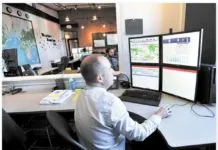Marine Weather Forecasting
Over the last few decades, there's been exponential growth in the availability of accurate weather forecasts and the net result is safer voyaging.
Government spending...
Vesper Class B AIS Sea Trial
During a recent passage from Sarasota, Fla., to Havana, Cuba, Practical Sailor had the chance to compare the new Vesper XB-8000 Class B AIS...
Sonar that Sees Whats Ahead
Most depthfinders are historical instruments. They collect and display information from the recent past-not the best arrangement for the sailor. By the time the...
Ultrasonic Wind Sensor Test
ConclusionsWhen ultrasonic sensors first gained a foothold in the sailboat market about 10 years ago, they struck us as expensive and fragile. Prices have...
How Do Ultrasonic Wind Sensors Work?
Youre standing on the sailboats bow on a windy day, facing the helm and yelling There is a rock ahead. Youre doing this while...
Reading the Wind Series, Part 3
Raymarine Tacktick T-033Raymarines Tacktick T-033 wireless, solar-powered system is ideal for the sailor who wants wind information on a smaller boat without having to...
Wired vs Wireless
To wire, or not to wire? This is a good question, and there are certainly some pluses and minus to consider. For sailors with...
Wireless Multiplexers
ConclusionIf your needs are fairly simple-combining an AIS with an NMEA 0183 instrument, for example-the Digital Yacht MUX100 and WLN10 or 10HS may be...
A NMEA 2000-and Beyond-Survival Guide
NMEA 2000 (aka NMEA 2K or N2K) is the communication standard replacing NMEA 0183. It is a technical standard (IEC 61162-3) used for connecting...
Wind Systems Part 2: Data Display and User Interface
Its dusk on an overcast, gusty day, and raw data is pouring into your wind display from the masthead, GPS, and the knotlog. Can...















































